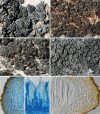Phylogeny, evolution and a re-classification of the Lichinomycetes
- PMID: 39717657
- PMCID: PMC11663425
- DOI: 10.3114/sim.2024.109.09
Phylogeny, evolution and a re-classification of the Lichinomycetes
Abstract
The Lichinomycetes is an independent lichenized lineage within the Ascomycota comprising ca. 390 species and 50 genera. Very few studies have dealt with family and genus classification using molecular data and many groups are in need of thorough revision. Thus, we constructed a multilocus phylogeny (mtSSU, RPB2 and mcm7 gene regions) including 190 specimens of Lichinomycetes belonging to 126 species. Ancestral state reconstruction analyses were carried out to trace the evolution of selected characters. The current classification scheme of the Lichinomycetes based on morphological and anatomical characters is in great conflict with the phylogenetic relationships resulting from the present study. The results suggest substantial non-monophyly at the family and genus levels. A revised classification is proposed here and an overview of genera accepted in the Lichinomycetes is given. Ancestral Lichinomycetes are reconstructed as crustose with pycnoascocarps and octosporous asci. We used a combination of characters to delineate groups including the ascoma development and the type of asci. The revised classification includes 11 new genera, five resurrected genera, and 54 new combinations distributed in four families (three emended and one new). Three new species are also described. Taxonomic novelties: New family: Lichinellaceae M. Schultz & M. Prieto. New genera: Allopyrenis M. Schultz & M. Prieto, Gonotichia M. Schultz & M. Prieto, Lapismalleus M. Schultz & M. Prieto, Lingolemma M. Schultz & M. Prieto, Paludolemma M. Schultz & M. Prieto, Paracyphus M. Schultz & M. Prieto, Peltolemma M. Schultz & M. Prieto, Pseudocarpon M. Schultz & M. Prieto, Pseudotichia M. Schultz & M. Prieto, Pycnolemma M. Schultz & M. Prieto, Tichocyphus M. Schultz & M. Prieto. New species: Paracyphus gotlandicus M. Schultz & M. Prieto, Pseudocarpon persimile M. Schultz & M. Prieto, Tichocyphus gotlandicus M. Schultz & M. Prieto. New combinations: Allopyrenis grumulifera (Nyl.) M. Schultz & M. Prieto, Allopyrenis haemaleella (Nyl.) M. Schultz & M. Prieto, Allopyrenis impolita (Th. Fr.) M. Schultz & M. Prieto, Allopyrenis phaeococca (Tuck.) M. Schultz & M. Prieto, Allopyrenis reducta (Th. Fr.) M. Schultz & M. Prieto, Allopyrenis sanguinea (Anzi) M. Schultz & M. Prieto, Allopyrenis tenuis (Henssen) M. Schultz & M. Prieto, Cladopsis densisidiata (Aptroot et al.) M. Schultz & M. Prieto, Cladopsis foederata (Nyl.) M. Schultz & M. Prieto, Cladopsis guyanensis (M. Schultz et al.) M. Schultz & M. Prieto, Cladopsis palmana (J. Steiner) M. Schultz & M. Prieto, Cladopsis polycocca (Nyl.) M. Schultz & M. Prieto, Forssellia canariensis (Henssen) M. Schultz & M. Prieto, Forssellia concordatula (Nyl.) M. Schultz & M. Prieto, Gonotichia octosporella (Lettau) M. Schultz & M. Prieto, Lapismalleus lugubris (A. Massal.) M. Schultz & M. Prieto, Lemmopsis lutophila (Arnold) M. Schultz & M. Prieto, Lempholemma segregatum (Nyl.) M. Schultz & M. Prieto, Lichinella baicalensis (Makryi) M. Schultz, Lichinella etoshica (Brusse) M. Schultz, Lichinella lusitanica (Henssen) M. Schultz, Lichinella pulvinata (E. Dahl) M. Schultz, Lichinella schleicheri (Hepp) M. Schultz, Lichinella terrestris (Makryi) M. Schultz, Lingolemma lingulatum (Tuck.) M. Schultz & M. Prieto, Paludolemma syreniarum (C.J. Lewis & M. Schultz) M. Schultz & M. Prieto, Peltolemma socotranum (M. Schultz) M. Schultz & M. Prieto, Phylliscum aotearoa (Henssen & B. Bartlett) M. Schultz & M. Prieto, Phylliscum cylindrophorum (Vain.) M. Schultz, Phylliscum laatokkaense (Vain.) M. Schultz & M. Prieto, Phylliscum neglectum (Henssen) M. Schultz & M. Prieto, Phylliscum permiscens (Nyl.) M. Schultz & M. Prieto, Phylliscum rhodostictum (Taylor) M. Schultz & M. Prieto, Porocyphus antarcticus (Cromb.) M. Schultz & M. Prieto, Porocyphus macrosporus (Henssen et al.) M. Schultz & M. Prieto, Porocyphus minutissimus (Henssen) M. Schultz, Porocyphus rosulans (A. Henssen) M. Schultz, Porocyphus tasmanicus (A. Henssen) M. Schultz, Porocyphus willeyi (Tuck.) M. Schultz & M. Prieto, Pseudotichia vermiculata (Nyl.) Schultz & M. Prieto, Pycnolemma polycarpum (M. Schultz) M. Schultz & M. Prieto, Synalissina botryosa (A. Massal.) M. Schultz & M. Prieto, Synalissina cladodes (Tuck.) M. Schultz & M. Prieto, Synalissina condensata (Arnold) M. Schultz & M. Prieto, Synalissina degeliana (P.M. Jørg.) M. Schultz & M. Prieto, Synalissina dispansa (H. Magn.) M. Schultz & M. Prieto, Synalissina intricatissima (J. Steiner) M. Schultz & M. Prieto, Synalissina isidiodes (Nyl. ex Arnold) M. Schultz & M. Prieto, Synalissina vesiculifera (Henssen) M. Schultz & M. Prieto, Thelignya arnoldii (Frauenf.) M. Schultz & M. Prieto, Thelignya lacustris (P.M. Jørg. & R. Sant.) M. Schultz & M. Prieto, Thelignya neglecta (Erichsen) M. Schultz & M. Prieto, Thelignya obtenebrans (Nyl.) M. Schultz, Thyrea osorioi (Henssen) M. Schultz. New status and combination: Gonotichia depauperata (Servít) M. Schultz & M. Prieto. Emended description: Lempholemma Körb., Lichina C. Agardh, Thelignya A. Massal., Lichinaceae Nyl., Phylliscaceae Th. Fr., Porocyphaceae Körb. Resurrection: Cladopsis Nyl., Collemopsis Nyl. ex Crombie, Forssellia Zahlbr., Pleopyrenis Clem., Synalissina Nyl. Citation: Prieto M, Wedin M, Schultz M (2024). Phylogeny, evolution and a re-classification of the Lichinomycetes. Studies in Mycology 109: 595-655. doi: 10.3114/sim.2024.109.09.
Keywords: Gloeoheppiaceae; Heppiaceae; Lichinaceae; Peltulaceae; ancestral reconstruction; ascoma ontogeny; new taxa.
© 2024 Westerdijk Fungal Biodiversity Institute.
Conflict of interest statement
The authors declare that there is no conflict of interest.
Figures































References
-
- Arnold F. (1864). Lichenen aus dem südöstlichen Tirol, gesammelt von L. Molendov. Verhandlungen der Kaiserlich-Königlichen Zoologisch-Botanischen Gesellschaft in Wien 14: 459–462.
-
- Altekar G, Dwarkadas S, Huelsenbeck JP. et al. (2004). Parallel Metropolis-coupled Markov chain Monte Carlo for Bayesian phylogenetic inference. Bioinformatics 20: 407–415. - PubMed
-
- Beimforde C, Feldberg K, Nylinder S. et al. (2014). Estimating the phanerozoic history of the Ascomycota lineages: combining fossil and molecular data. Molecular Phylogenetics and Evolution 77: 307–319. - PubMed
LinkOut - more resources
Full Text Sources
